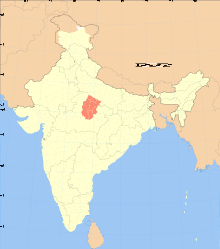Bundelkhand

Bundelkhand ( Hindi : बुंदेलखंड , jejakbhukti ) is a geographic region in northern India . The region is now in the states of Uttar Pradesh and Madhya Pradesh , with Madhya Pradesh accounting for the largest part. From 1854 Bundelkhand was administratively part of the Central India Agency . During the Indian uprising of 1857 it was one of the rebellious regions.
geography
The Bundelkhand region lies between the Vindhya Mountains in the south and the Ganges plain in the north; to the east borders the less fertile historical region of Baghelkand . The Bundelkhand region, which is supplied with water by numerous rivers (including Betwa , Chambal , Ken , Sindh and others), is extremely fertile. The main cities in the region are Jhansi , Datia , Lalitpur , Sagar , Damoh , Orai , Panna , Mahoba , Banda , Narsinghpur and Chhatarpur . The major cities of Gwalior , Jabalpur and Bhopal are culturally strongly influenced by the Bundelkhand region, which is particularly evident in the language used. Large parts of the region lie at heights of approx. 200 to 300 m ; the Vindhya Mountains, which run through the south of the region, reach maximum heights of approx. 600 m .
economy
Agriculture forms the basis of economic life; much of the area is also covered by scrub forest. In the small and medium-sized towns, handicrafts and trade developed, which were supported by the service industry. The Panna mines are known for their finds of smaller diamonds. In the last decades of the 20th century, tourism in Khajuraho and Orchha became more important as a source of income.
history
The area belonged to the tribal areas of the Gond and Kol . The region's first known ruling dynasty were the Gaharwars, followed by the Guptas , Pratiharas and Chandellas . In the 13th century, the Sultanate of Delhi was the most important power in northern India, but the sultans let the Chandellas control the later Bundelkhand region. In the 14th century Rajputs immigrated from the Bundela tribe , who gradually took power in the 16th century and cooperated with the Mughals ; the region owes its name to them. The center of their power was Orchha , founded in 1531 ; At the end of the 17th century, the Bundela leader Chhatrasal revolted against the central power of the Mughals under Aurangzeb and allied with the Marathas under Shivaji . As a result, smaller, quasi-independent princely states emerged in Datia , Panna , Ajaigarh , Bijawar , Charkari and elsewhere. Nominally, the British took power in the 19th century, but power was largely wielded by the Maharajas .
Attractions
Among the most famous places in the Bundelkhand region is Khajuraho with his by the UNESCO as a world heritage site classified temple area and other temples scattered from the 10th and 11th centuries. The palace complex and the chhatris of the rulers of Orchha are also among the more popular attractions in the region. Also of historical significance are the stupa of Bharhut , which has only survived in ruins , the rarely visited Gupta temples of Bhumara and Deogarh , the memorial buildings of Dhubela , the destroyed temples and still intact mosques of Mahoba , the ruins of Dudhai and the Kalinjar Fort .
See also
- The former Avadh (or Oudh ) region borders to the north of Bundelkhand .


